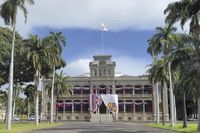Across the globe, a quiet but determined movement is underway to preserve endangered languages and the cultures they embody. From the classrooms of southwestern Benin to the mountains of Calabria, from the windswept coasts of Scotland to the sunlit shores of Hawaii, communities are fighting to keep their ancestral tongues alive. Each story is unique, yet all are bound by a common thread: the belief that language is much more than a means of communication—it's the very heart of identity, memory, and belonging.
In the commune of Kloukname, in southwestern Benin, the Saint Salomon learning center stands as a beacon of linguistic resilience. Founded in 2014, this small school serves 85 children aged 6 to 13, and its daily routine is defined by the teaching of Adja, the language of the Aja people. The school’s approach is a rare exception in a country where French, the official language and a colonial legacy, dominates the education system and is spoken by only about 35% of the population. Benin, with over 70 national languages, has long marginalized this rich linguistic diversity in its formal schooling, making Saint Salomon’s efforts all the more significant.
“Language is culture. You can’t be traditional in a destroyed language. Everything we do, we do in our language, and that’s how it’s done,” says Ninivi, a student at Saint Salomon, as quoted by Brasil de Fato. Fellow student Kohoke echoes this sentiment, emphasizing the practical necessity of learning one’s native tongue: “It’s better to speak one’s native language than to speak a language that doesn’t belong to us.” She points out the disconnect that arises when children are educated only in French: “If you’re in a place with people speaking your native language and you don’t understand, that’s a bummer. Because in our schools, we only learn French, only French.”
The school’s bilingual approach, led by teacher Alain Mathias, divides lessons between French and Adja. “After fifth grade, the children have to go to school, where only French is spoken. So, here, I mix the two languages to allow the children to understand what’s really going on,” Mathias explains. His method is hands-on: “If a child says ‘bonjour’ (good morning in French), I make the hand gesture and express myself in Adja to greet them. And the things I show on the board, I also automatically translate.” For many children, this is the only chance to become literate in their mother tongue, especially if they haven’t learned it at home.
Principal Davito Roger is outspoken in his call for change, urging President Patrice Talon’s government to incorporate mother tongue instruction across Benin’s primary schools. “It’s a form of domination. They know very well that language is indispensable. Countries that have developed, developed in their own language. Therefore, if someone can’t speak their own language, they’re lost,” Roger argues. He adds, “If the state wanted to set a good example, it should start by helping us here, follow our example, and replicate it throughout the country. They know this, but they don’t want to.”
Meanwhile, in the Scottish region of Argyll and Bute, the Gaelic language is experiencing a renaissance, buoyed by government support and community enthusiasm. According to the Argyll and Bute Council, the area’s Gaelic Language Plan, running from 2022 to 2026 under the Gaelic Language (Scotland) Act, is part of a broader statutory commitment to promote the language. The Council works hand-in-hand with Bòrd na Gàidhlig, the public body responsible for Gaelic development, ensuring that local initiatives align with the National Gaelic Language Plan.
One of the most visible successes has been the Royal National Mod in Oban, a cultural festival that in 2024 drew record crowds and generated an economic impact of around £3.6 million. An Comunn’s impact report revealed that 86% of attendees were likely to return to Oban for future visits—a testament to the event’s power to foster both linguistic pride and economic vitality. The Council’s Strategic Events and Festivals funding further amplifies Gaelic’s presence, with eight out of twelve supported events celebrating the language and culture.
Gaelic’s visibility extends beyond festivals. The Council has launched the Gaelic for Business promotion, encouraging the use of Gaelic in commercial, retail, food and drink, and tourism sectors. The Film In Argyll and Bute website, targeting production companies, also highlights the cultural significance of Gaelic, weaving the language into the region’s identity as a destination for film and television. Councillor Audrey Forrest, the Council’s Policy Lead for Gaelic, sums up the region’s commitment: “Encouraging and promoting the use of the Gaelic language and its significance across the region is embedded within that work, and this report makes clear our commitment to both the language and wider Gaelic culture.”
Across the Atlantic in Hawaii, the revitalization of the Hawaiian language has made headlines. Yet, as Civil Beat notes, this revival has not been without challenges. While more people are speaking Hawaiian today than in decades past, there remains a disconnect in understanding the deeper historical and cultural context of the language. The struggle to reconnect with the past while building a future for the language is ongoing, with advocates stressing the importance of not just learning to speak, but also to understand the stories, values, and worldview embedded in every word.
In a very different corner of the world, the mountains of Calabria in southern Italy echo with the sounds of Grecanico, a rare form of ancient Greek. According to FRANCE 24, this language has survived since the days of Magna Graecia in the 8th century BCE, weathering empires, invasions, and centuries of neglect. Today, only a few hundred speakers remain, and most are elderly. “There’s only a few hundred of us left. I’m one of the youngest, and I’m 71 years old,” says Tito Squillaci, a leader in the fight to preserve Grecanico. The language lives on in traditional songs, oral storytelling, and community memory, but its future hangs in the balance.
Efforts to revive Grecanico include a week-long school held each August, where speakers of all ages gather to learn and celebrate their linguistic heritage. These gatherings are more than educational—they are acts of cultural preservation, moments when a community comes together to resist the erasure of its identity.
What unites these diverse stories is the recognition that language is not just about words or grammar. It is the vessel of culture, history, and collective memory. Whether in Benin, Scotland, Hawaii, or Italy, the fight to preserve endangered languages is a fight for the soul of a people. Each classroom lesson, festival performance, or community workshop is a small victory against the tide of forgetting, ensuring that the voices of the past can still be heard in the present—and, hopefully, far into the future.




